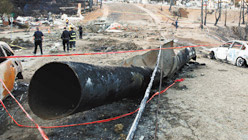
Update 2:25 p.m. The NTSB has posted the Executive Summary of its Pipeline Accident Report, which includes 28 findings. Read it here.
The NTSB says this under a section called Probable Cause:
The National Transportation Safety Board determines that the probable cause of the accident was the Pacific Gas and Electric Company’s (PG&E)
(1) inadequate quality assurance and quality control in 1956 during its Line 132 relocation project, which allowed the installation of a substandard and poorly welded pipe section with a visible seam weld flaw that, over time grew to a critical size, causing the pipeline to rupture during a pressure increase stemming from poorly planned electrical work at the Milpitas Terminal; and
(2) inadequate pipeline integrity management program, which failed to detect and repair or remove the defective pipe section.
Contributing to the accident were the California Public Utility Commission’s (CPUC) and the U.S. Department of Transportation’s exemptions of existing pipelines from the regulatory requirement for pressure testing, which likely would have detected the installation defects. Also contributing to the accident was the CPUC’s failure to detect the inadequacies of PG&E’s pipeline integrity management program.
Contributing to the severity of the accident were the lack of either automatic shutoff valves or remote control valves on the line and PG&E’s flawed emergency response procedures and delay in isolating the rupture to stop the flow of gas.
Some of the more interesting findings:
- The accident pipe would not have met generally accepted industry quality control and welding standards in 1956, indicating that those standards were overlooked or ignored.
- PG&E’s inadequate quality control during the 1956 relocation project led to the installation and commissioning of a defective pipe that remained undetected until the accident, 54 years later.
- The 2008 sewer line installation did not damage the defective pipe that later ruptured.
- The internal line pressure preceding the rupture did not exceed the PG&E maximum allowable operating pressure for Line 132 and would not have posed a safety hazard for a properly constructed pipe.
- PG&E lacked detailed and comprehensive procedures for responding to a large-scale emergency such as a transmission line break, including a defined command structure that clearly assigns a single point of leadership and allocates specific duties to supervisory control and data acquisition staff and other involved employees.
- The 95 minutes that PG&E took to stop the flow of gas by isolating the rupture site was excessive.
- Use of automatic shutoff valves or remote control valves along the entire length of Line 132 would have significantly reduced the amount of time taken to stop the flow of gas and to isolate the rupture.
The board also makes 29 recommendations to six different entities, including PG&E, CPUC, the federal Pipeline and Hazardous Materials Safety Administration, and the Governor of California. Many of the recommendations are for new regulations or the toughening of old regulations.
KQED Radio’s Cy Musiker will be talking with South Bay Congresswoman Jackie Speier about the report at 5:30 p.m. Speier, who sent out many tweets from the hearing today, has been a fierce critic of PG&E. You can listen to that live on the radio or right here online. Check here for an archive of the discussion afterward.